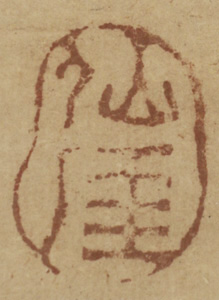Zenga
Bamboo in the windSigned: -
Seals: Sengai
Technique: sumi on paper 78,8 x 27
Mounting: brown and grey damask and green silk 171,5 x 35,6
Condition: aged, soiled and old restorations. The painting fair, the mounting in good
The inscription reads: 瀟湘時夜雨 Shôshô jiya'u (!), ”Rain in the nocturnal hours in Hunan.”
Hunan is a Chinese province, but also the name of Xiao Xiang, the two rivers. The Xiao is the main feeder of the Xiang. The location where they come together is one of the so-called eight famous places of Hunan. This sight is known for rain drops hanging from bamboo in humid nights.
Hunan is famous for its bamboo (which is often used for bunjin utensils.)
Sengai was a monk of the Rinzai sect. He was known for his controversial teachings and writings, as well as for his lighthearted sumi-e painting - a preacher full of wit and greatly concerned with spiritual welfare of ordinary people; a modest man. Not much information about him, because he did not want any writing to be done on his life.
He was born in a poor farming family with lots of brothers and sisters in (todays) Gifu-prefecture. At the age of eleven he started religious training at a local temple. Looking promising he was sent to leading Zen masters near Nagata.
About 1787 he was invited to come to Shôfuku-ji in Hakata on Kyûshû. The Shôfuku-ji, founded in 1195, although small was one of the oldest Zen temples in Japan. He became abbot in 1789 and retired in 1811, to become abbot again in 1836. In the meantime he lived near the Shôfuku-ji.
Reference:
Next to many monographs
Roberts p. 142
Rosenfield '99 B.79
Price: ON REQUEST

